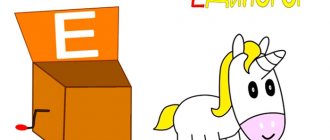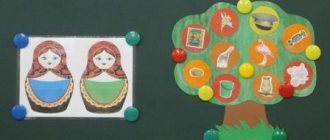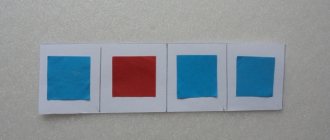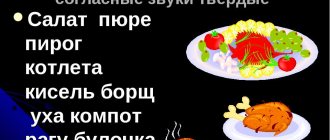Summary of educational activities for preparing for teaching literacy in the senior group on the topic “Sounds [a], [u]. Letters A, U"
author: Gantseva Marina Arkadyevna
Teacher-speech therapist Federal State Budgetary Preschool Educational Institution "Kindergarten No. 568", Yekaterinburg
Summary of educational activities for preparing for teaching literacy in the senior group on the topic “Sounds [a], [u]. Letters A, U"
Summary of educational activities for preparing for teaching literacy in the senior group
on the topic “Sounds [a], [u]. Letters A, U"
The summary was compiled by:
Gantseva M. A. (teacher-speech therapist)
Federal State Budgetary Educational Institution "Kindergarten No. 568", Yekaterinburg
Tasks:
- clarify the concept of “vowel sounds”;
- learn to differentiate the sounds [a], [u];
- learn to highlight the first sound in a word;
- learn to select words with a given initial sound using visual support and without it;
- develop phonemic hearing;
- develop skills in sound analysis and synthesis of syllables, reading syllables (ay, ua);
- fix the graphic image of the letters A, U;
- develop memory;
- cultivate curiosity, interest in sounds and letters;
- cultivate a caring attitude towards things (aids used in class).
Equipment:
- laptop, projector, speakers, presentation; cards for continuous reading of syllables (au, ua); magnetic board, red chips (magnets); letters A, U; pointer; diagram for determining the place of a sound in a word, red chip;
- for children: individual mirrors; diagrams for determining the place of a sound in a word; sound pencil cases (with chips in red, green and blue); notebooks; cards for continuous reading of syllables (au, ua); cash registers; simple pencils, counting sticks (letter set).
GCD move:
- Introductory part. Game "Memorize and repeat"
:
| watermelon – shark – orange pineapple – apricot – Africa album – stork – arch | morning - street - ear Ulya - mind - mustache already - knot - clever |
Articulation gymnastics
. “Window”, “Tube”, “Window - tube”, moving the lips with a “proboscis” to the right and left, “Horse”.
SLIDE No. 2
- Main part:
1) “Sounds [u], [a], we know you!”:
— What sounds did we study? (A, U) Let's remember about them, everything we know.
SLIDE No. 3
- How is Anya crying? (A)
SLIDE No. 4
- How does a wolf howl? (U)
SLIDE No. 5
- Now listen to me and guess who it is: Anya or the wolf? (The speech therapist pronounces the sounds [a], [u] several times, the children guess everything together and individually)
SLIDE No. 6
Clarification of the articulation of sounds [a], [u].
Children tell the snail about the articulation of the sound [u], and Aibolit - about the articulation of the sound [a].
The articulation analysis plan appears gradually in the presentation:
- lips
- teeth
- language
- how the air comes out of the mouth (freely) - a “breeze” flies out (picture)
Guessing sounds from silent articulation.
SLIDE No. 7
- What color are the sounds [a], [u]? In what color castle do the sounds [a], [u] live? (Children choose)
SLIDE No. 8
Characteristics of sounds (vowel sounds). Children tell Dunno.
- What is the sound? (Vowel) Why? (Air comes out of the mouth freely).
- What is the sound? (Vowel) Why? (Air also comes out of the mouth freely).
SLIDE No. 9
2) Game “Name the first sound in the word.”
The speech therapist and children take a diagram to determine the place of a sound in a word, put a red chip in the first window (the sound at the beginning of the word)
Pictures appear on the screen, children name them by highlighting the first sound and clicking on the chip. Children name the first sound (all together and individually).
Pictures: pineapple, stork, duck, bus, iron, fishing rod, shark, oranges, snail, duckling, apricot, street.
3) Didactic game “Guess the word” (based on pictures).
SLIDE No. 10
The speech therapist says: “I will make words. To guess a word, you will need to add the first sound to it - [a] or [y]. Pictures will help you guess the words.” Vocabulary material: ...pelsins, ...tyug, ...bus, ...tenok, ...bricot, ...fabric, ...litka, ...daughter, ...kula, ...faces, ...nanas, ...ist..
4) Physical exercise “A or U?”
The speech therapist pronounces the sounds [a], [u]. Children, if they hear the sound [a], pretend to be a stork; if they hear the sound [u], they pretend to be a Cheburashka with big ears.
SLIDE No. 11
— Guys, let's talk about the letter U.
SLIDE No. 12
5) Letter U.
- Showing a letter.
- Finding a letter in the cash register.
- “How many elements does the letter U have? What are these elements? What does this letter look like?
- Laying out letters from sticks.
- Game “Right - Wrong” (Children determine whether the letter U is written correctly)
SLIDE No. 13
- Drawing a letter in the air (On the screen there is a slide with animation - a snail is crawling, helping to correctly draw the letter U in the air).
SLIDE No. 14
- Game “Identify the sound U”. Children name the pictures that appear on the letter U, emphasizing the sound [u]. Perform finger exercises:
- “Fishing rod” - show the index finger of the right hand (the other fingers are clenched) and rotate the thumb of the left hand.
- “Snail” - first depict a snail with one hand (show the index and middle fingers - “horns”), move the hand along the table (“the snail is crawling”), then with the other hand.
- “Iron” - depict an iron (put one hand palm down on the table, the other hand on top, “iron”).
- “Duck” - show “beaks” with hands.
SLIDE No. 15
6) Game “Decorate the letter U”
. Children take turns naming words with the sound [y] at the beginning of the word. Each child says a word, and flowers appear on the screen (on the letter U).
SLIDE No. 16
— We remembered everything we know about the letter U. Now let's talk about the letter A.
Letter A - first letter a
alphabet (Children notice that the word “alphabet” begins with the sound [a].
7) Letter A.
- Showing a letter.
- Guys, find the letters A on this slide (the speech therapist calls one child to the board, he shows the letters with a pointer: A, a)
- “How many elements does the letter A have? What are these elements?
SLIDE No. 17
- Laying out letters from sticks.
SLIDE No. 18
- Finding a letter in the cash register.
- What does this letter look like?
SLIDE No. 19
- Drawing a letter in the air (On the screen there is a slide with animation - watermelons are moving, helping to correctly draw the letter A in the air).
SLIDE No. 20
 Game “Decorate the letter A”
Game “Decorate the letter A”
. Children take turns naming words with the sound [a] at the beginning of the word. Each child says a word, and flowers appear on the screen (on the letter A).
SLIDE No. 21
9)
Analysis and synthesis of the syllable AU.
The speech therapist shows a picture of Uli (Ulyana).
— Ulya went into the forest. There were a lot of mushrooms in the forest. While picking mushrooms, she went far into the forest and did not notice how she lost her way. Ole became scared. She remembered a short but very necessary word. If you shout, they will hear you and come to your aid. What word is this? (Aw!)
Children slowly pronounce the “word” AU in chorus and in rows.
- Name the first sound in the word Au (A). What is the sound? (vowel). It is indicated by a red chip (Children place the red chip on the table, and the speech therapist on the magnetic board).
- Name the second sound in the word Au (U). What is the sound? (vowel). Label it.
- The first sound is [a]. The second sound is [u]. What happened? (AU) Let’s “read” the word. I lead with a pointer, and you slowly sing each sound in the word (AU).
- Now let’s designate the sounds with letters. Let's read the word (using a card for continuous reading of the syllable AU).
SLIDE No. 22
10) Analysis and synthesis of the syllable UA
.
The speech therapist shows a picture of a crying child.
— The baby cries: “Wow!”
Children slowly pronounce the word UA in chorus and in rows.
The syllable UA is parsed similarly.
SLIDE No. 23
11) Typing syllables
AU, UA.
SLIDE No. 24 with the inscription “Well done!”
- The result of GCD. Reflection.
- Name words with the sound A. Name words with the sound U.
Summary of educational activities for preparing for teaching literacy in the senior group on the topic “Sounds [a], [u]. Letters A, U"
Summary of a lesson on speech development in the preparatory group on the topic: “Sound U, letter U”
4. - Guys, now let's pronounce the sound [U] and see what position our lips take? ( lips are drawn out
).
The sound U
is pronounced smoothly, drawn out, the air coming out of the mouth does not meet any obstacles. The sound can be sung freely, which means the sound U is a vowel.
- Is this sound a vowel or a consonant? (vowel)
How did you determine that it is a vowel? Correct, because we can sing it and it does not meet any obstacles.
This sound is always sung
This sound flows like a song.
Sound, fly freely
No obstacles on the way!
-What color will we use to denote this sound? (red)
-Let's remember the sounds we make (hear and pronounce)
-Each sound has its own written sign - a letter. What are we doing? (we see and write).
-The sound U is indicated by the letter U (I show)
-Look at the letter U. How many sticks does it consist of (two).
-Please note that one stick is long and the other is short.
-Guys, look at the board. This is the letter U. Remember, the sound [U] in the letter is indicated by the letter U.
The letter U looks like the ears of a bunny on the top of its head. The snail's horns also look like the letter U.
-Let's write the letter U in the air-
-Let's try to make the letter U
from counting sticks.
- Physical exercise.
Wolves howl at the moon: U-U-UUU (walk stealthily like a wolf)
I sing a sad song: U-U-UUU (imitation of singing into a microphone)
The wind howls strongly: U-U-UUU (we shake our hands like tree branches)
The train is quietly approaching: U-U-UUU (we show the movement of the train with our hands)
I stand and sing in a clear voice (claps in front of me)
Because it is melodious, this vowel U
6.Playing on the carpet
-And now you and I will catch the sound of U with our palms. Clap your hands only when you hear the sound of U - then you will catch it. There is no need to catch other sounds.
U-a-u-i-o-i-u-a-u-o-o
7. Game "One-many" with the ball
- I will name one object, and you will name many objects. (For example: table-tables).
Snail, iron, ear, already, mustache, street, smile, pointer, duck
We go to the tables
8.Game at the tables
-Guys, you have red circles if you hear the sound U
raise the circle.
Words: spider, flower, puddle, varnish, sofa, poppy, table, iron, chair, beetle, goose, already, smile, book, pointer, notebook, ruler, mustache.
9.Work on sheets of paper
-You have pieces of paper with different letters on your tables, but you will have to find the letter “U” among them and circle it!
10. Game “What is not there”
We name all the pictures that hang on the board.
If the sound U is in these words? Now let’s name all the pictures, remember them, and photograph them with our eyes. and now you close your eyes.
-What’s missing? (working on the correct use of singular and plural nouns in the R case)
11. Summing up the lesson.
- Guys, remember what sound we met in class today?
-With what letter?
-What color do we use?
-What did you like most?
- Well done, they studied well, listened carefully, answered questions.
Literature:
2. I am learning sounds and letters. Literacy workbook for children 5 - 7 years old
Makhaneva M.D.
Target. Teach children to analyze a sound series consisting of two vowel sounds; introduce the letter Uy; exercise the ability to navigate the plane of a sheet (directions: top to bottom and bottom to top).
Equipment. A set of pictures, a plot picture, a panel of letters; sheets of paper with flowers drawn below and paper bees (according to the number of children).
Preliminary work. Children draw flowers on individual sheets (at the bottom of the sheet).
Progress of the lesson
I. 1. The teacher tells a story, emphasizing the sound [u] with his voice.
- Today I will tell you about a little bee. Her name was Ulya. One early morning Ulya flew out of the hive house. She flew to the meadow beyond the distant forest to collect honey. Ulya hummed cheerfully:
Oooh, ooh, ooh
I'll collect a lot of honey!
Near the pond, Ulya saw a duck. Mother duck taught ducklings to swim.
Ulya flew on. She looks at her friend crawling on a pebble. “Good morning, really!” - “Good morning, Ulya!” The bee flew on, singing:
Oooh, ooh, ooh.
I’ll collect honey for everyone!
2. - What song did Ulya sing? (Oooh.) The bee's song is similar to the sound [u]. Remember the words with the sound [u] from the story about the bee Ulya (if the children cannot remember, the teacher asks leading questions).
- What sound do these words begin with? (With the sound [y].) Highlight this sound in the words with your voice.
3. Articulation of sound. When pronouncing a sound [y], the lips are in the shape of a tube, the tongue lies behind the lower teeth, the air passes calmly and smoothly, without encountering an obstacle in its path, the sound is pronounced with the voice (the vocal cords vibrate).
Characteristics of sound.
— What do we call sounds that are pronounced with the voice and do not meet obstacles in the mouth? (Vowel sounds.) So the sound [y] is a vowel.
II. 1. — While flying through the forest, Ulya heard someone shouting: “Ay!” This girl is lost. Ulya tells her:
ooh-ooh, ooh-ooh,
Come after me. I'll take it out.
Ulya took the girl out of the dense forest and brought her all the way to the house. The girl had a little brother. The baby cried: “Wa-wa.” The bee left him honey. And she flew on.
The teacher invites the children to remember how the lost girl screamed in the forest (ay) and the crying baby in the crib (wa).
- How many sounds do you hear in a word? (The teacher sings a-a-a - oo-oo-oo, then oo-oo-oo - a-a-a.) What is the first sound in a word? What's the second sound? What sounds are these? (Vowels.)
Working with circuits - sound beads (both beads are red sounds).
2. The teacher suggests remembering and repeating Uli’s songs.
III. 1. Introducing the letter.
The teacher shows a card with a picture of the letter Uu. The letter moves into the apartment on the letter panel at the address: sixth floor (topmost row), apartment No. 2.
— The letter Uu lives next to the letter Aa. They are neighbors in our house.
2. Analytical and synthetic activities. (Similar to lesson 3.)
IV. Exercise “Bee in the meadow” to develop orientation on a sheet of paper and reinforce the direction from top to bottom and bottom to top.
The teacher gives the children their sheets with painted flowers and paper bees.
- Finally, Ulya the bee flew to the meadow. (Children place the bees at the top of the sheet.) A bee flies and looks down. So many beautiful flowers. The bee began to sit on the flowers and collect nectar. It will sit on one flower, then rise into the air again. And he sits down again. And it will rise again.
Where is the bee? (Above.) Where do flowers grow? (Below.) When a bee lands on a flower, how does it fly? (From top to bottom.) And when does it rise from the flower? (Bottom up.) Show how a bee flies.
Children follow the teacher’s instructions, moving the bees along the sheet and accompanying the actions with the appropriate words: top to bottom, bottom to top, etc.
Lesson notes for senior speech therapy group Topic: Sound [U]
Tasks:
Correctional and educational: introduce children to the sound “U” and its characteristics; introduce the concept of “vowel sound”; develop the ability to identify a vowel sound at the beginning of a word;
Correctional and developmental: develop phonemic processes, fine and articulatory motor skills; attention, memory, logical thinking.
Correctional and educational: develop the ability to listen to each other, listen carefully to the teacher’s speech.
Equipment: symbol of the sound U, red house, object pictures, symbol of the vowel sound.
Progress of the lesson:
- Organizing time:
- Breathing exercise: “Blow the pencil onto the edge of the table.”
- Gymnastics for the eyes: “Draw a spring.”
- Finger gymnastics: “Massage of palms with a Su-Jok ball.”
- Main stage:
- Lesson topic message:
How do wolves howl? How does the wind howl in winter? Today we will get acquainted with the sound U.
- Sound characteristics:
Prolonged pronunciation of a sound. Analysis of articulatory posture.
Look in the mirror. What position are your lips in? The tongue lies calmly at the bottom of the mouth, the teeth are brought together but not closed, the air stream calmly leaves the mouth without encountering an obstacle. “Stretch the thread” and sing, “wind the thread onto a ball.” The sound U is a vowel, will live in a red house. We will denote it with a small circle.
- Development of phonemic hearing:
Game "Catch the Sound". Sound production by clapping the ear:
From a series of vowels: a, u, i, a, i, u, a, y, u.
From reverse syllables: ah, uh, om, um, ik, uk.
From the words: August, beehive, stork, fishing rod, student.
- Fixing sounds in syllables:
Game “Remember, repeat” (repetition of syllable rows following the speech therapist)
Um-um-um, um-um-um, whoop-whoop, whoop-whoop, whoop-whoop.
Dynamic pause : “Bees” (Vocabulary work with the word “hives”).
The bees are sitting in the hives, they are looking at me.
Bees, get out of the hives and collect honey quickly.
- Fixing sounds in words:
Game "Shop"
On the board are pictures with the sound U at the beginning of the word and two pictures with a different sound. The speech therapist names the pictures, highlighting the sound U, then tells the children that he is the seller, and the children are the buyers. They only need to buy items that begin with the sound U.
- Development of attention:
Picture game “What’s missing?”
- Fixing sounds in sentences:
Negotiating sentences using subject pictures
They swim in the river... They quack on the shore... Mom irons clothes... A boy draws...
- Result:
What sound did you encounter today? What sound is this? Why? Place words with the sound “U” in my palm.






